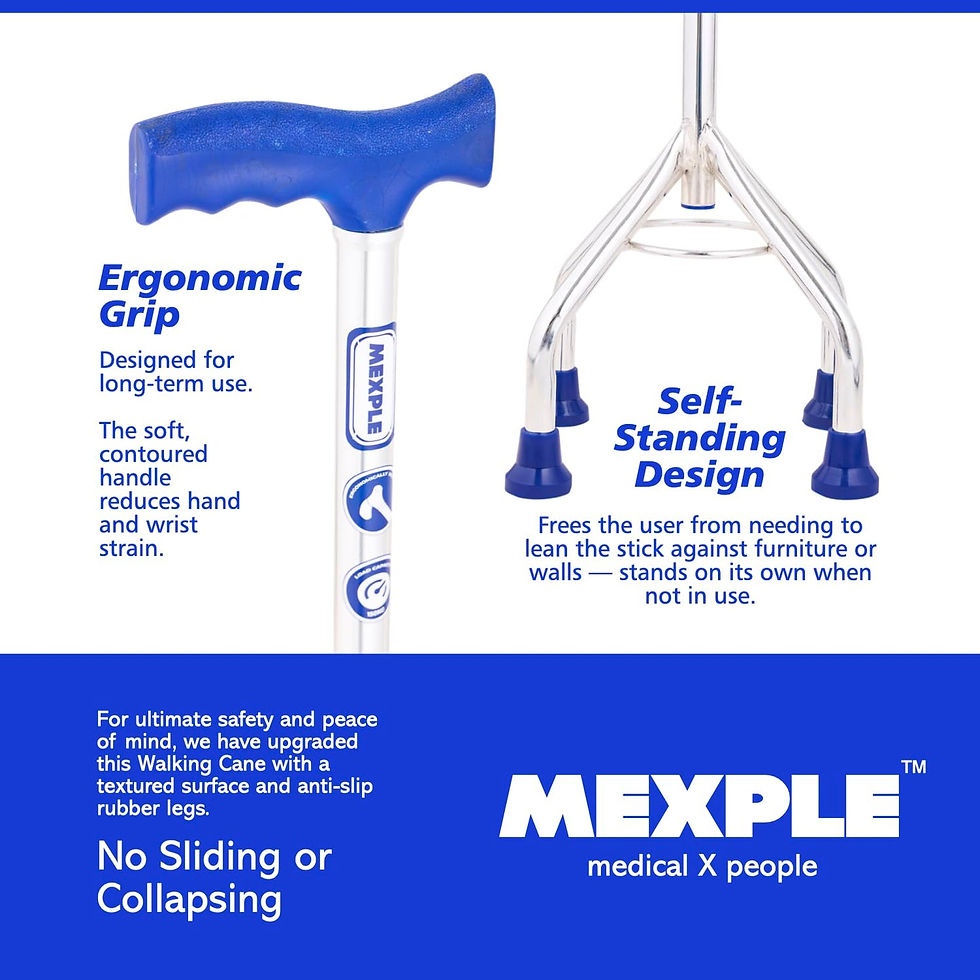How to Maintain and Clean Your Wheelchair Safely
- mexple11
- Sep 18
- 3 min read
A wheelchair is more than just a mobility aid—it is an essential part of daily life for many individuals. Whether you use it temporarily during recovery or rely on it for long-term support, proper care and maintenance are crucial to ensure safety, comfort, and durability. A well-maintained wheelchair not only functions smoothly but also reduces the risk of accidents, infections, and costly repairs. In this guide, we’ll walk you through practical steps to maintain and clean your wheelchair safely at home.
Why Wheelchair Maintenance Matters
Like any other piece of equipment, wheelchairs undergo regular wear and tear. Dirt, dust, moisture, and daily usage can affect their performance. Neglecting maintenance may lead to issues such as:
Loose bolts or screws causing instability.
Worn-out brakes reducing safety.
Rust and corrosion weakening the frame.
Dirty cushions or upholstery leading to skin irritation or infection.
By cleaning and inspecting your wheelchair regularly, you can extend its life, improve hygiene, and ensure safe usage.

Daily Care Tips
1. Wipe Down After Use
After returning indoors, wipe the wheelchair frame, wheels, and footrests with a damp cloth to remove dirt, dust, or mud. This is especially important during rainy seasons when wheels may bring in moisture and grime.
2. Check Brakes
Always check that the brakes engage and release properly before use. If they feel loose or less effective, adjustments or replacements may be needed.
3. Cushion and Seat Hygiene
Cushions and upholstery should be checked daily for spills or sweat. Moisture left for too long can cause odors, stains, and even skin problems. Use a clean, dry cloth to wipe them down, and keep a spare cover handy.
Weekly Cleaning Routine
1. Wash Removable Parts
If your wheelchair has removable cushions, covers, or detachable footrests, wash them once a week. Use mild detergent and allow them to dry completely before reattaching.
2. Clean the Wheels and Rims
Wheels accumulate dust, mud, and hair, which can reduce traction and cause uneven movement. Use a brush to clean the treads and wipe down the rims. For powered wheelchairs, check the tires for punctures or cracks.
3. Inspect for Wear and Tear
Look for any signs of damage such as bent spokes, cracked frames, or loose nuts and bolts. Addressing small issues early prevents bigger, costlier repairs later.
Monthly Maintenance Checklist
1. Lubricate Moving Parts
Apply a wheelchair-safe lubricant to axles, bearings, and joints to ensure smooth movement. Avoid over-lubricating as it may attract dust.
2. Brake System Check
Test the brakes thoroughly to ensure they lock firmly when engaged. If they slip or don’t hold properly, tightening or replacing them is necessary.
3. Frame Inspection
Check for signs of rust or corrosion, especially in steel-framed wheelchairs. Wipe off any moisture and apply an anti-rust spray if needed.
4. Battery Care (For Powered Wheelchairs)
For electric models, inspect the battery terminals for corrosion, keep the battery charged, and avoid overcharging. Store the chair in a dry environment to prolong battery life.
Safe Cleaning Practices
While cleaning is essential, it’s equally important to do it safely:
Avoid harsh chemicals: Strong cleaners can damage upholstery or paint. Use mild soap and warm water.
Dry thoroughly: Never leave moisture on the chair, as it can lead to rust and mold growth.
Check manufacturer’s manual: Follow specific cleaning and maintenance guidelines provided with your wheelchair model.
Do not disassemble unnecessarily: Unless you are trained, avoid dismantling complex parts. Seek professional service for repairs.
Professional Servicing
Even with regular home care, wheelchairs should be serviced professionally at least once or twice a year. Technicians can perform detailed inspections, replace worn parts, and fine-tune performance. This ensures long-term safety and reliability.
Hygiene Tips for Long-Term Users
Use antimicrobial wipes for quick cleaning when outdoors.
Keep a spare cushion cover for regular replacement.
Store the wheelchair in a clean, dry place, away from direct sunlight and excessive moisture.
For shared wheelchairs (in hospitals or care centers), disinfect thoroughly between uses to prevent infections.
Conclusion
Maintaining and cleaning your wheelchair safely is not just about appearance—it directly impacts comfort, safety, and independence. With a simple routine of daily care, weekly cleaning, and monthly maintenance, you can extend the life of your wheelchair and ensure it remains a reliable companion in your daily activities. Regular servicing combined with safe cleaning practices helps prevent accidents and keeps the wheelchair in peak condition.
Remember, a wheelchair is more than equipment—it’s your mobility partner. Treat it with care, and it will continue to support you with confidence and ease.




Comments